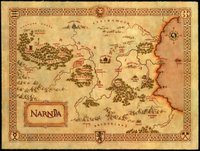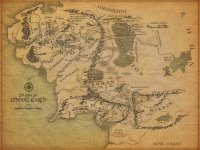Narnia vs. Middle Earth


John Ronald Reuel Tolkien (sadly I didn’t have to look up either of these names) constructed Middle Earth to slake his insatiable intellectual appetite. Quite simply, The Lord of the Rings is a work of literary and linguistic genius, not to be devalued by its inclusion in geek-lit, escapist arenas.
More specifically, the LOTR “trilogy” is an exercise in creating a world, replete with its own languages, history and customs that go deep. The story of Frodo and the ring is almost an add-on; a small but significant chronicle in the narrative yarn of Middle Earth. The account of Frodo exists to justify the reality of Middle Earth. Narnia is the opposite: a fabrication which exists to serve the story of Aslan, the Pevensie children and their progeny.
That’s not to undercut the narrative value of either book. I’ve read LOTR since I was ten years old, and the Narnia series since before that, and I love them both. But I think Tolkien’s work is the greater, in terms of scope and narrative complexity, not to mention character development. I don’t think Lewis’s format of around 200 pages per book allows the reader enough time to truly sympathize with the characters of Narnia. There are a few exceptions (namely Aslan and the Pevensie children), but these are spread out throughout the series. Lewis’s character, King Caspian, for example, doesn’t command the loyalty and affection of an Aragorn because, quite simply, he hasn’t been on the page long enough.
Translated to the silver screen, I think Narnia’s brevity provided a better opportunity for movie adaptation than for Middle Earth. All throughout The Fellowship of the Ring, while simultaneously enthralled to the stunning imagery of the movie, I was subtly disappointed in the incongruity between movie and book (though such divergence is to be expected). Additionally, I found that despite the movie’s three-hour length, it felt like it was rushing through key scenes at break-neck speeds.
Narnia got the better end of the motion picture stick. With a smaller page count, Andrew Adamson was able to give The Lion, the Witch and the Wardrobe fair treatment. Having read the book many times, I can say that there is very little, if any, detail missing from page to screen. To his credit, Adamson even manages to flesh out certain details (like the
That said, I believe the Lord of the Rings movie series is more timeless, and will continue to beguile audiences well past its 25th-year anniversary, while Narnia will fill DVD collections for a few years, falling into oblivion as DVDs are replaced with some new technology.
(There are numerous parallels between the two worlds that I would love to draw on, but I think my readership is thinning and I’m scared to bore you any more than I already have).


2 Comments:
Too late, I'm bored!
And yet you read the whole thing. Hmmm....
Post a Comment
<< Home